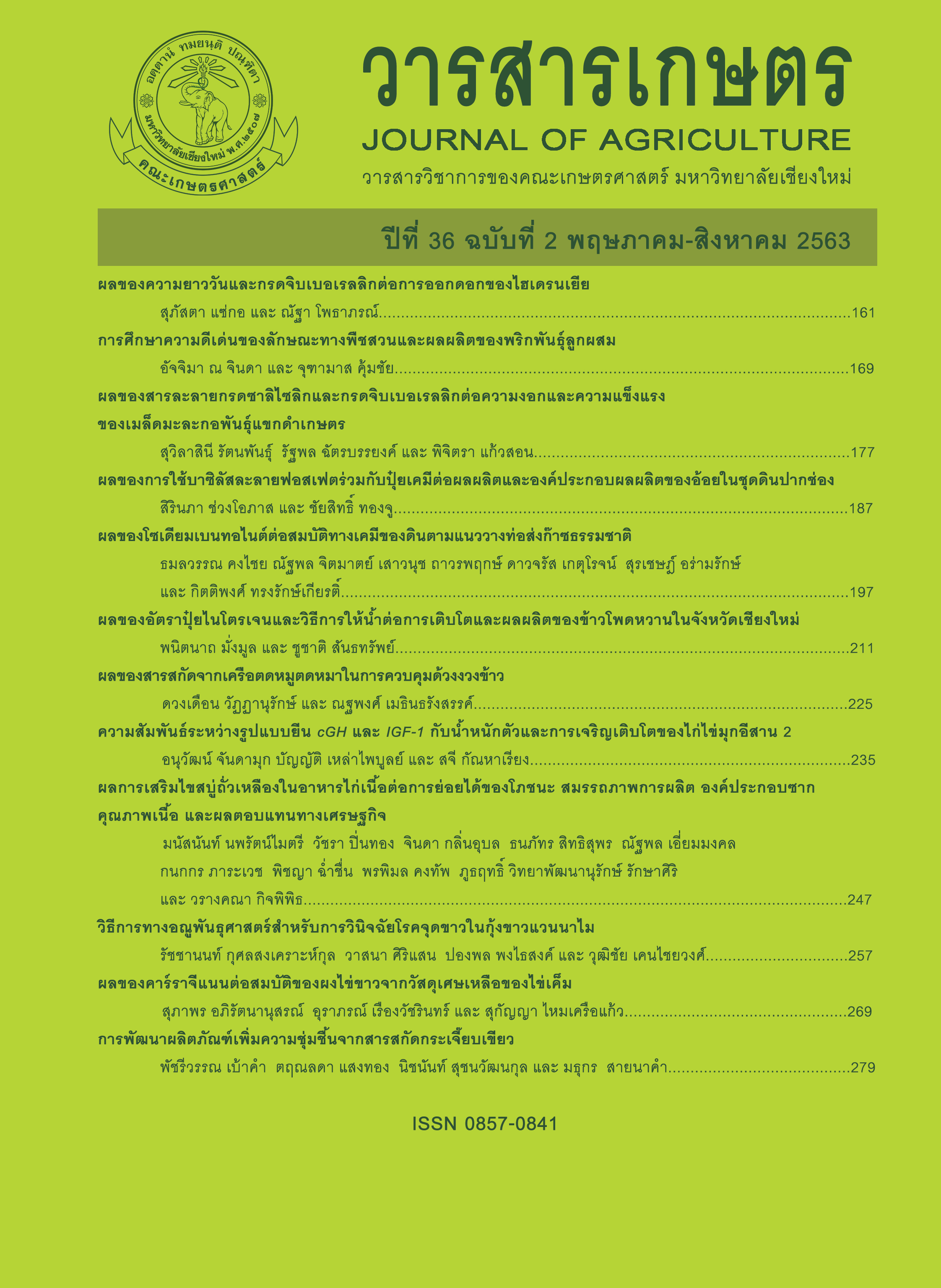ผลของโซเดียมเบนทอไนต์ต่อสมบัติทางเคมีของดินตามแนววางท่อส่งก๊าซธรรมชาติ
Main Article Content
บทคัดย่อ
โซเดียมเบนทอไนต์เป็นวัสดุหล่อลื่นหัวเจาะลอดสิ่งกีดขวางสำหรับการวางท่อส่งก๊าซธรรมชาติ ซึ่งทำให้โซเดียมเบนทอไนต์ปะปนอยู่ในดินธรรมชาติซึ่งอาจส่งผลต่อการเปลี่ยนแปลงสมบัติทางเคมีของดิน จึงทำการศึกษาผลของโซเดียมเบนทอไนต์ต่อสมบัติทางเคมีของดินตามแนววางท่อส่งก๊าซธรรมชาติเพื่อประเมินผลต่อสมบัติของดินทางการเกษตร โดยเลือกตัวแทนชุดดินจากสองกลุ่มดินคือดินปรี้ยวจัดและดินทั่วไปตามแนวท่อก๊าซธรรมชาติจากจังหวัดระยองถึงนนทบุรี โดยมีดินเปรี้ยวจัดจำนวน 3 ชุดดิน ได้แก่ ชุดดินเสนา (Se) ชุดดินองครักษ์ (Ok) และชุดดินบางน้ำเปรี้ยว (Bp) และมีกลุ่มดินปกติจำนวน 3 ชุดดิน ได้แก่ ชุดดินสตึก (Suk) ชุดดินห้วยโป่ง (Hp) และชุดดินสัตหีบ (Sh) ทำการจำลองการปนเปื้อนโซเดียมเบนทอไนต์โดยการบ่มดินในสัดส่วนโซเดียมเบนทอไนต์ต่อดินเท่ากับ 1:10, 2:10, 3:10, 4:10, 5:10, 6:10: 7:10, 8:10, 9:10, 10:10 เป็นเวลา 2 สัปดาห์ แล้วทำการวิเคราะห์สมบัติทางเคมีของดิน ได้แก่ ค่า pH, ค่าการนำไฟฟ้าขณะดินอิ่มตัวด้วยน้ำ (ECe), ความจุแลกเปลี่ยนแคตไอออน (CEC), อัตราร้อยละโซเดียมแลกเปลี่ยนได้ (ESP), อัตราส่วนการดูดซับโซเดียม (SAR), และโซเดียมที่แลกเปลี่ยนได้ (exch. Na) วิเคราะห์สหสัมพันธ์ของข้อมูล ผลการศึกษาพบว่า การเพิ่มสัดส่วนโซเดียมเบนทอไนต์ทำให้ค่า pH, CEC, ESP และ SAR ในดินเปรี้ยวจัดเพิ่มขึ้นอย่างมีนัยสำคัญทางสถิติ และทำให้ค่า ECe, CEC, ESP และ SAR ในกลุ่มดินปกติ เพิ่มขึ้นอย่างมีนัยสำคัญเช่นเดียวกัน นอกจากนี้ อัตราโซเดียมเบนทอไนต์มีสหสัมพันธ์เชิงบวกแบบเอกโพเนนเชียลกับ pH ESP และ SAR ในกลุ่มดินเปรี้ยวและดินปกติ ผลการศึกษานี้แสดงให้เห็นว่าโซเดียมเบนทอไนต์ทำให้สมบัติดินทั้งในดินเปรี้ยวจัดและดินปกติเปลี่ยนแปลงเข้าใกล้สมบัติของเบนทอไนต์โดยเฉพาะ ESP และ SAR ซึ่งจำเป็นต้องมีการจัดการหากมีการปนเปื้อนเบนทอไนต์ในพื้นที่ในสัดส่วนโซเดียมเบนทอไนต์ต่อดินตั้งแต่ 1:10 ขึ้นไป
Article Details
เอกสารอ้างอิง
Attanandana, T. 2007. Paddy Soil. Department of Soil Science, Faculty of Agriculture, Kasetsart University, Bangkok. 393 p. (in Thai)
Bloom, P.R. and U. Skyllberg. 2012. Soil pH and pH buffering. pp. 19-1 to 19-14. In: P.M. Huang, Y. Li and M.E. Sumner (eds.). Handbook of Soil Sciences: Properties and processes. 2nd ed. CRC Press, Boca Raton, FL.
Buol, S.W., R.J. Southard., R.C. Graham and P.A. McDaniel. 2011. Soil Genesis and Classification. 6th ed. Wiley-Blackwell, Ames, Iowa. 543 p.
Chhabra, R. 2005. Soil Salinity and Water Quality. A.A. Balkema Publishers, Brookfield.
Chittamart, N., S. Tawornpruek, D. Ketrot, S. Aramrak, K. Chittanukul and R. Sattapun. 2018. Utilization of Na-bentonite to improve pH-buffering capacity of acid sulfate soils in natural gas transmission pipeline rights-of-way, Thailand. Journal of IOP Science (IOP Conference Series: Earth and Environmental Science) 151(2018) 012023, doi: 10.1088/1755-1315/151/1/ 012023.
Chunlapan, P. 2001. Solid waste leachate treatment by coagulation process with bentonite. M.S. Thesis. Kasetsart University, Bangkok. 163 p. (in Thai)
Croker, J., R. Poss, C. Hartmann and S. Bhuthorndharaj. 2004. Effects of recycled bentonite addition on soil properties, plant growth and nutrient uptake in a tropical sandy soil. Plant and Soil 267(1-2): 155-163.
Department of Mineral Resources. 2007. Mineral and rock used in the industry. (Online). Available: http://www.dmr.go.th/ewt_news. php?nid=1033&filename=m (September 24, 2007). (in Thai)
Dollhopf, D.J. and B.J. Bauman. 1981. Bentonite mine land reclamation in the northern great plains. Montana Agricultural Experiment Station Research Report 179, Montana State University, Bozeman. 41 p.
FAO. 1976. Prognosis of salinity and alkalinity. FAO Soil Bulletin 31. FAO, Rome.
Inglethorpe, S.D. J., D.J. Morgan, D.E. Highley and A.J. Bloodworth. 1993. Industrial Minerals Laboratory Manual: Bentonite. Technical Report WG/93/20: Mineralogy and Petrology Series. British Geological Survey, Keyworth, Nottingham. 116 p.
Kheoruenromne, I. 2005. Soil Survey. Department of Soil Science, Faculty of Agriculture, Kasetsart University, Bangkok. (in Thai)
Kheoruenromne, I. 2007. Acid Sulfate Soil in Thailand. Text and Jurnals Publishing, Bangkok. (in Thai)
Lesturgez, G., R. Poss, C. Hartmann, E. Bourdon, A. Noble and S. Ratana-Anupap. 2004. Roots of Stylosanthes hamata create macropores in the compact layer of a sandy soil. Plant and Soil. 260: 101-109.
Ljung, K., F. Maley, A. Cook and P. Weinstein. 2009. Acid sulfate soils and human health - A millennium ecosystem assessment. Environment International 35(8): 1234-1242.
Meesuk, L., M. Ruaysap and P. Wathanakul. 2000. Potentiality of Thai bentonite for soybean oil decolourisation. pp. 242-247. In: Proceedings of the 40th Kasetsart University Annual Conference: Science. Kasetsart University, Bangkok. (in Thai)
National Soil Survey Center. 1996. Soil Survey Laboratory Methods Manual. Soil Survey Invest. Report. No 42, Version 3.0.USDA, U.S. Government Printing Office, Washington, D.C.
Sangkum, P. 2009. Effects of Na-bentonite on soil properties and growth of Rayong 5 cassava variety. M.S. Thesis. Kasetsart University, Kamphaeng Saen Campus, Nakhon Pathom. (in Thai)
Schuman, G.E., E.J. Depuit and K.M. Roadifer. 1994. Plant responses to gypsum amendment of sodic bentonite mine spoil. Journal of Range Management 47(3): 206-209.
Sanchez, P.A. 2019. Properties and Management of Soils in the Tropics. 2nd ed. Cambridge University Press, Cambridge. 666 p.
Troeh, F.R. and L.M. Thompson. 2005. Soils and Soil Fertility. 6th ed. Blackwell Publishing, Oxford.
Uresk, D.W. and T. Yamamoto. 1986. Growth of forbs, shrubs, and trees on bentonite mine spoil under greenhouse conditions. Journal of Range Management 39(2): 113-117.
Voorhees, M.E. 1986. Infiltration rate of bentonite mine spoil as affected by amendments of gypsum, sawdust and inorganic fertilizer. Reclamation and Revegetation Research 5: 483-490.
Weil, R.R. and N.C. Brady. 2017. The Nature and Properties of Soil. 15th ed. Prentice Hall, Upper Saddle River, New Jersey.


